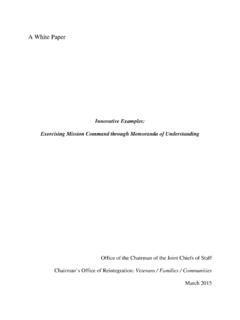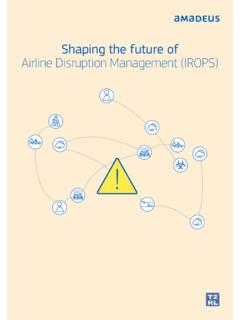Transcription of ELECTF. Reproduced From Copy AD-A20`4 134a
1 U j This DocumentELECTF. Reproduced FromBest Available CopyAD-A20`4 134aThe Yiews expresed in thn paper am thOm? of the authcxawl do not aeamsazily reflect the views Of the tDwartmm or Ddemer or any of its wmiscis Thisdocuwait may not Le reItud for open pubticatio W10tit Ixas bef itadei by the appropeate mititazy swryke orTASK FORCE 1-41 INFANTRY:FRATRICIDE EXPERIENCEIN SOUTHWEST ASIABYLIEUTENANT COLONEL JAMES L. HILLMANU nited States ArmyDISTRIBUTION STATEMENT A:Approved for public is CLASS OF ARMY WAR COLLEGE, CARLISLE BARRACKS, PA 17013-505093-~ 06:-CURITY eASSIFICATION OF THIS PAGEiForm Aoo~rovodREPORT DOCUMENTATION PAGE OMBNo. 0704-0188la. REPORT SECURITY CLASSIFICATION RESTRICTIVE MARKINGSU nclassified24. SECURITY CLASSIFICATION AUTHORITY 3. DISTRIBUTION/ AVAILABILITY OF REPORTA pproved for public release;21b. OECLASSIFICATIONIOOWNGRAOING SCHEDULE distribution is PERFORMING ORGANIZATION REPORT NUMBER(S) 5. MONITORING ORGANIZATION REPORT NUMBER(S)68.
2 NAME OF PERFORMING ORGANIZATION 6b. OFFICE SYMBOL 7a. NAME OF MONITORING ARMY WAR COLLEGE J6C. ADDRESS (City; State. ant ZIP Code) ;j ;-,OORESS (Ciy. State..na ZIP Cod#)ROOT HALL, BUILDING 122 CARLISLE, PA 17013-5050Ba. NAME OF FUNDING I SPONSORING ab. OFFICE iY4"MBOL 3 :2 OCUREMENT iNSTRUMENT !DENTIFICATION NUMBERORGANIZATION (If aDo0 aide)8C. AOORESS (G'ly, ZIPCoae) 0 ,0 URCE OF -'JNOING NUMBERS;2 OGRAM PROJECT 7 ASK WRK UNITV EMENT NO. NO. NO. ACCESSION :, 7;TLE (InCuoae SecurnY CJjmtCa00an)rask Force 1-41 Infantry: Fratricide Experience in Southwest Asia12. ;ERSONAt. AUTHORIS) James L. Hillman, LTC, USA13a. TYPE OF REPORT [13b. TIME COVERED Z TE OF REPORT (Year. Montn, Day) Is. PAGE COUNTFROM ."__ ..15 April 1993 4816. SUPPLEMENTARY --CSATI COOES .3. SUGJEC7 7 ERMS (Ccnrinue on reverse ir necesury ana 'aentiry ay otocx numaer;IELD I I ROUP I IUi-GROUP19. A&STRACT (Continue on reverse of necesafy ana iaentfy oy oWocK numoerThe war in the Persian Gulf was a quick, decisive victory forcoalition forces.)]
3 However, despite military success on thebattlefield, the high frequency of fratricide was a cause forprofessional and public concern. Although fratricide is not a newbattlefield lethality at extended ranges without concurrentadvances in friendly identification capabilities. This hasexacerbated the problem of fratricide. Army concerns resulted ina significant effort under the umbrella of the Army's FratricidePrevention Action Plan. The Army Materiel Command (AMC) and theTraining and Doctrine Command (TRADOC) are jointly exploringsolutions to improve the Army's situational awareness and combatidentification capabilities through a combination of training and20. OISTRIBUTION /AVAILABILITY OF ABSTRACT 21. ABSTRACT SECURITY CLASSIFICATIONSUNCLASSIFIEOIUNLIMITED 0 SAME AS RPT. -OTIC USERSZZa. NAME OF RESPONSIBLE INOIVIDUAL 22b. TELEPHIONE (Include Area Code) 22c. OFFICE SYMBOLDr. James W. Williams 717/245-4427 m USAMHID0 form 1473, JUN 86 previous editions are obsolete.
4 SECURITY CLASSIFICATION OF THIS PAGE technological fixes. This paper is a description and analysis ofthree incidents of fratricide suffered by the 1st Battalion, 41stInfantry Regiment during Operation Desert Storm. Each incident isexamined, in the context of the environment and circumstances ofthe battlefield at the time of occurrence, to determine theproximate and contributing causes of the engagement. The paperconcludes with recommendations to maintain the focus of the Army'sefforts through the Fratricide Prevention Action Plan, avoid overreliance on technological solutions, and expand situationaltraining MILITARY STUDIES PROGRAM PAPERThe vievs expressed in this paper are those of theauthor and do not necessarily reflect the vieva ofthe Department of Defense or any of Its8 document may not be released for open publicationuntil it has been cleared by the appropriate militaryservice or government Force 1-41 Infantry:Fratricide Experience in Southwest AsiaDESERT STORM PERSONAL EXPERIENCE MONOGRAPHbyLieutenant Colonel Tames L.
5 HillmanUnited States ArmyDr. James WilliamsProject AdvisorDISTdIBUTION STATEMENT A: Approved for publicreleases distribution Is Army War CollegeCarlisle Barracks, Pennsylvania 17013 -ATc cesio i A&F 0 --15 April 1993 Slf rNTIS CRA&eDTIC TABU rlann)oUJCrdJustficationByy1 Istribution -UNCLASSIFIED Availability CodesAvail irJd/orS vecal .. WSIECTM LABSTRACTAUTHOR: James L. Hillman, LTC, USATITLE: Task Force 1-41 Infantry: Fratricide Experience inSouthwest AsiaFORMAT% Desert Storm Personal Experience MonographDATE: 15 April 1993 PAGES 48 CLASSIFICATION: UnclassifiedThe war in the Persian Gulf was a quick, decisive victory forcoalition forces. However, despite military success on thebattlefield, the high frequency of fratricide was a cause forprofessional and public concern. Although fratricide is not a newbattlefield phenomenon, improved technology has resulted in greaterbattlefield lethality at extended ranges without concurrentadvances in friendly identification capabilities.
6 This hasexacerbated the problem o fratricide. Army concerns resulted ina significant effort under the umbrella of the Army's FratricidePrevention Action Plan. The Army Materiel Command (AMC) and theTraining and Doctrine Command (TRADOC) are jointly exploringsolutions to improve the Army's situational awareness and combatidentification capabilities through a combination of training andtechnological fixes. This paper is a description and analysis ofthree incidents of fratricide suffered by the 1st Battalion, 41stInfantry Regiment during Operation Desert Storm. Each incident isexamined, in the context of the environment and circumstances ofthe battlefield at the time of occurrence, to determine theproximate and contributing causes of the engagement. The paperconcludes with recommendations to maintain the focus of the Army'sefforts through the Fratricide Prevention Action Plan, avoid overreliance on technological solutions, and expand situationaltraining euphoria after the victory of coalition forces overIraq was replaced by consternation and frustration over thefrequency of In August 1990, the Department ofDefense officially notified the families of 35 soldiers andmarines that their loved ones died from friendly fire.
7 Publicdiscussion was carried out in every forum from newspapers totelevision, radio talk shows to gossip magazines. The public,initially lulled by news broadcasts depicting the false sterilityof Air Force gun-camera tapes, wanted to know how a high technologyarmy could kill or maim their own the war in the Persian Gulf, I commanded Task Force 1-41 Infantry. My task force suffered three fratricidal engagementsat the cost of six soldiers killed and thirty-to wounded. Thepurpose of this paper is to determine if the Army's efforts todevelop solutions to the problems ol fratricide will achieve theirpurpose. This paper describes the conditions and situations inwhich the, fratricidal engagements occurred, analyzes and determinesthe cause(s) of each incident, and compares the causes withpreventive actions under consideration or adopted by the Army. Thefinal sections contain conclusions and is not a new battlefield phenomena. In a seminalstudy in 1982, Lieutenant Colonel Charles R.
8 Shrader conducted aresearch study for the Army Combat Studies Institute placingfratricide in an historical The extremely low numberof combat casualties during the war with Iraq (615 killed andwounded) compared to previous mid and high-intensity conflictshighlighted the incidents due to friendly fire. Where forces experienced friendly fire casualties at a rate of abouttwo percent of total casualties, the Southwest Asia friendly firecasualty rate was twenty-three percent. Although the two percentrate can be argued to be higher, no one argues that twenty-threepercent is leaders were not blind to the dangers of fratricide inthe Gulf War. In January 1990 the theater commander, GeneralSchwarzkopf, asked for help in devising combat vehicle markingsystems for use the theater. The Army Vice Chief of Staff, GeneralSullivan, directed the Training and Doctrine Command (TRADOC) andthe Army Materiel Command (AMC) to develop combat identificationdevices for use in the war.
9 The two commands formed the CombatIdentification Task Force which fielded quick solutions consistingof thermal tape, Budd and DARPA They arrived too late toapply in most units. Thermal tape has since proven to have limitedvalue to mark vehicles at ranges over one thousand meters. Buddand DARPA lights provide a visual marker under passive night visiondevices but are not visible through the thermal systems used byArmy ground and air combat most common marking system was a black inverted "V"painted on the sides of vehicles. It was developed in response tofears of engaging coalition vehicles identical to those used by theIraqis. Another common markar was red aircraft marking panels tiedto the back or top of all vehicles. Although many field expedients2were tried, limited visibility markings tended to be filteredflashlights tied to bustle racks and vehicle As with theBudd and DARPA lights, these markings were not visible throughthermal the aftermath of the war the Army moved aggressively toidentify causes of friendly fire and find preventive measures.
10 TheArmy is working to enhance capabilities in situational awarenessand positive combat identification. SITUATIONAL AWARENESS is thereal-time accurate knowledge of one's own location (andorientation), as well as the locations of friendly, enemy,neutrals, and noncombatants. This includes awareness of the METT-Tconditions that impact the operation. POSITIVE IDENTIFICATION isthe immediate, accurate, and dependable ability to discriminatebetween friend and foe through optical sights and thermal imagingsystems. Optimally this ability extends to maximum engagement andacquisition range, and neither increases vulnerability, nordecreases system great deal of progress has occurred in the two years sincethe end of the Gulf War. A sixty-five minute fratricide preventiontraining video was produced by the Army Combined Arms Command(CAC). The Center for Army Lessons Learned (CALL) produced twofratricide prevention pamphlets, while the Army Materiel CommandCombat Identification Task Force began testing selected combatidentification (IFF) devices for combat vehicles.














